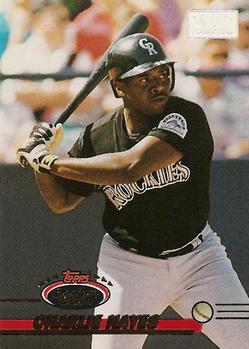This is part of a series of posts. Please read our methodology here)
Charlie Hayes played 1 4 years in the majors and was liked enough to do two tours of duty with 3 different franchises–the Giants (1988-89 & 1998-99), the Phillies (1989-1991 & 1995) and the Yankees (1992 & 1996-97). By virtue of playing an important position, third base, and being a consistently above-average defender, he turned out a career WAR of 10.5 despite being a below-average hitter for a corner infielder.
4 years in the majors and was liked enough to do two tours of duty with 3 different franchises–the Giants (1988-89 & 1998-99), the Phillies (1989-1991 & 1995) and the Yankees (1992 & 1996-97). By virtue of playing an important position, third base, and being a consistently above-average defender, he turned out a career WAR of 10.5 despite being a below-average hitter for a corner infielder.
Hayes posted by far his best offensive season when he joined the Rockies in their inaugural season of 1993. And this season wasn’t just a “Coors effect”–his 118 OPS+ was 4th in the NL among 3Bs, just behind Gary Sheffield (120) and Dave Hollins (119), who all trailed leader Matt Williams (137) by a good chunk.
In 1993 Hayes had career bests in all of his slash-line categories, posting .305/.355/.522 vs career numbers of .262/.316/.398. He posted career highs in just about every offensive statistic, including hits, HR, 2B, SB, RBI, and R.
All this translated to +12 WAR batting runs that season. In his 13 other seasons, he totaled -92 batting runs, with every season being negative save a +3 in 1998.
Like many players on this countdown, Hayes is probably remembered as a better offensive player than he actually was, thanks to substantial value in his defense and his deserved longevity in the majors.
